Monday Oct. 9, 2006
Optional Assignment #3 was collected in class
today. You'll find answers to the questions
online.
The Experiment #2 reports and the revised
Expt. #1 reports were collected. The Expt. #2 reports will take
about a week to grade. You should expect them back next week.
Experiment #3 materials should be available
in class on Friday.
The Scientific Paper is now available
(you can write a report on this paper instead of writing a book report
or doing an experiment). Reports will be due in three weeks on
Monday Oct. 30.
Copies of the Quiz #2 Study
Guide were handed out in class.
There might be a question or two on this week's quiz with the
following new format.
Most students go to
_______ during the day and_______ at night.
a. school, sleep
b. school,
school c. sleep,
sleep d. sleep, school
You should select answers a, b, c, or d. The first word in each
answer is meant to fill in the first blan, the second word is for the
second blank. The correct answers is:
Most students go to school during
the day and sleep
at night.
a. school, sleep
b. school, school c. sleep,
sleep d. sleep, school
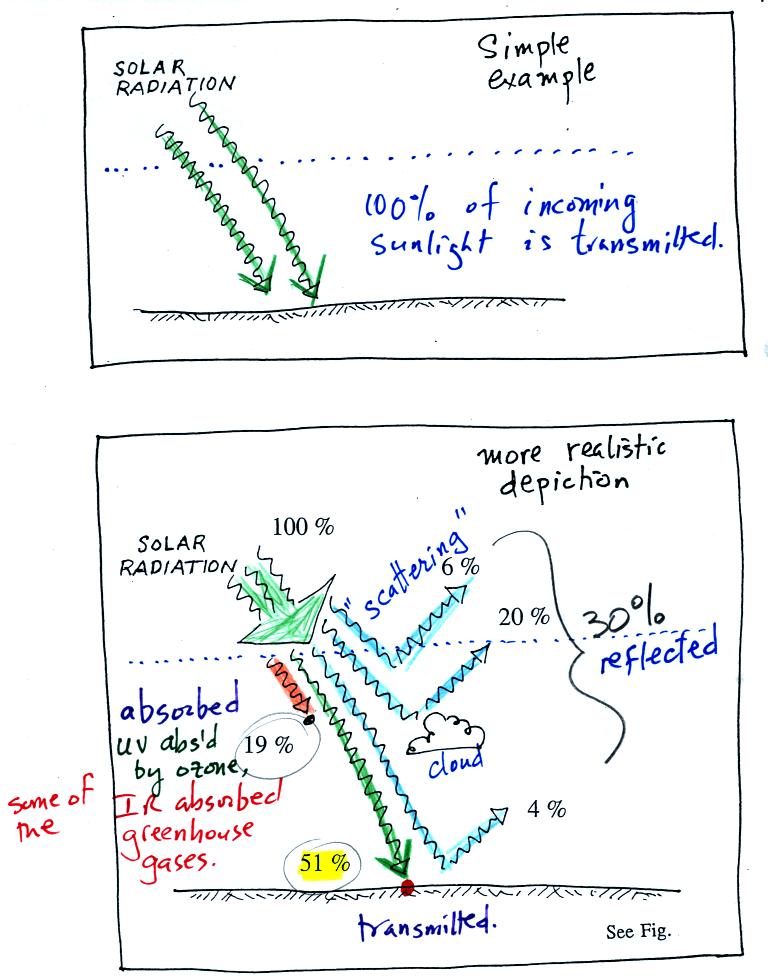
In our simplified version of the greenhouse effect we assumed that
100%
of the sunlight arriving at the top of the atmosphere passes through
the atmosphere and gets absorbed by the ground. The bottom figure
above shows that in reality only about 50% of the incoming sunlight
gets absorbed at the ground.
About 20% is absorbed by gases in the atmosphere. Sunlight is a
mixture of UV, VIS, and IR.
Ozone and oxygen will absorb a lot of the UV (though there isn't much
UV in sunlight) and greenhouse gases will absorb some of the IR
radiation in sunlight (there's a lot more IR in sunlight than UV).
The remaining 30% of sunlight is reflected by the ground, by clouds,
and even by air molecules themselves. Because this energy isn't
absorbed it doesn't warm the atmosphere or the ground. It's as if
this energy wasn't even there.
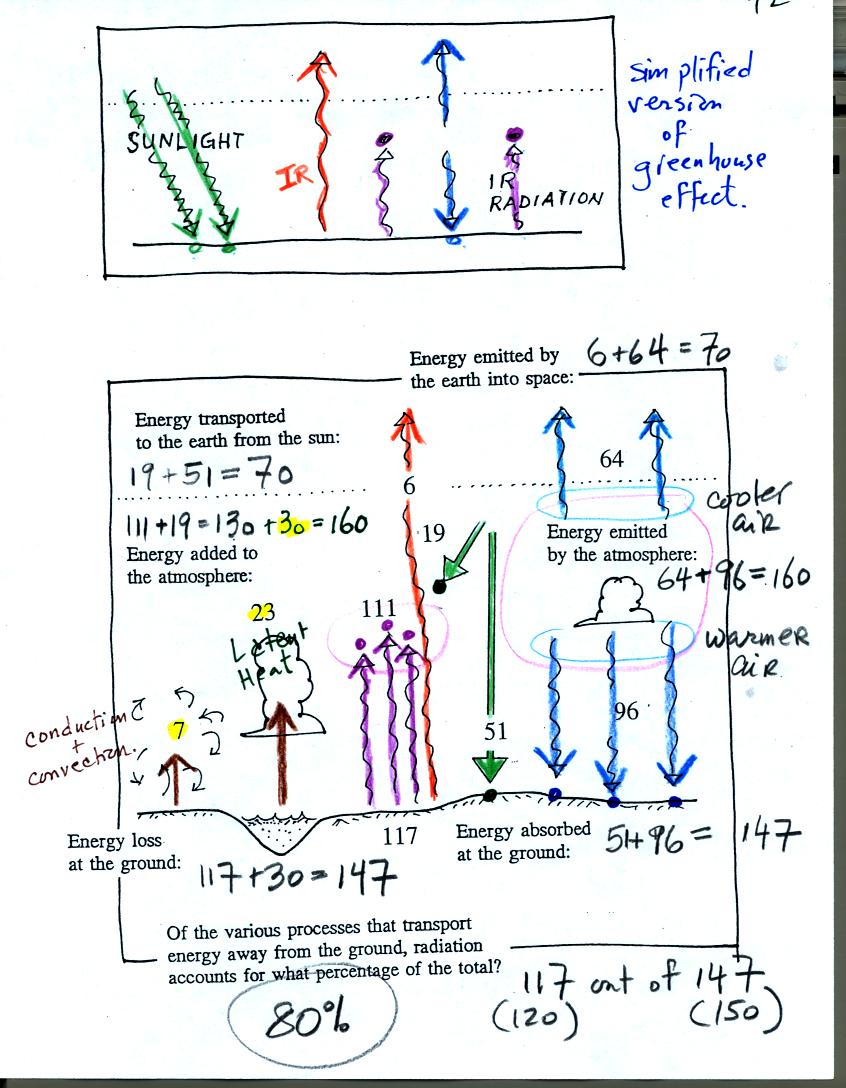
The simple
figure at the top of p. 72 in the photocopied
notes was meant to show you how the greenhouse effect works. The
green arrows represent incoming sunlight. The orange arrow is IR
radiation emitted by the earth at a wavelength that is transmitted by
the atmosphere. The two purple arrows are also IR radiation
emitted by the earth but at wavelengths that are absorbed by the
atmosphere. The blue arrows are IR radiation emitted by the
atmosphere.
The busy figure at the bottom of p. 72 is a more complete
and more
realistic depiction of energy balance on the earth. Because you
now know something about what happens
to sunlight arriving at the earth and passing through the atmosphere
and because you know about what can happen to IR radiation emitted by
the earth, you should be able to identify each of the various parts of
the figure and should be able to check for energy balance.
We'll break the figure above into manageable pieces. We will
start with the emission of energy by the atmosphere.
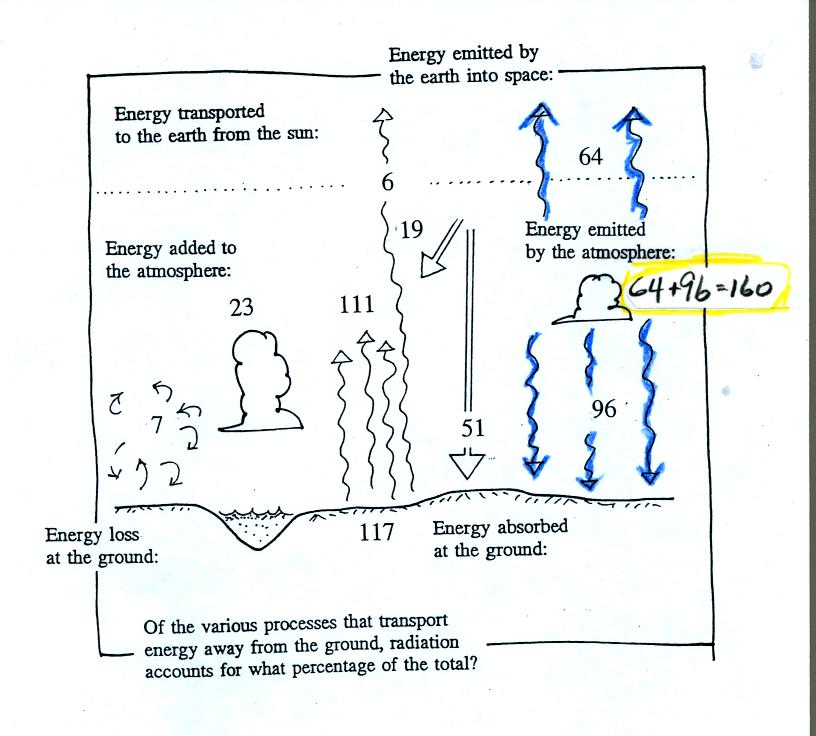
The atmosphere emits 64 units upward into space and 96 units downward
to the ground. Why the difference? This is a question about
what determines how much energy an object (the atmosphere) can
emit. The answer is temperature. Warm objects emit
more energy (or emit energy at a higher rate) that cold objects.
The upper atmosphere must be colder than the lower atmosphere.
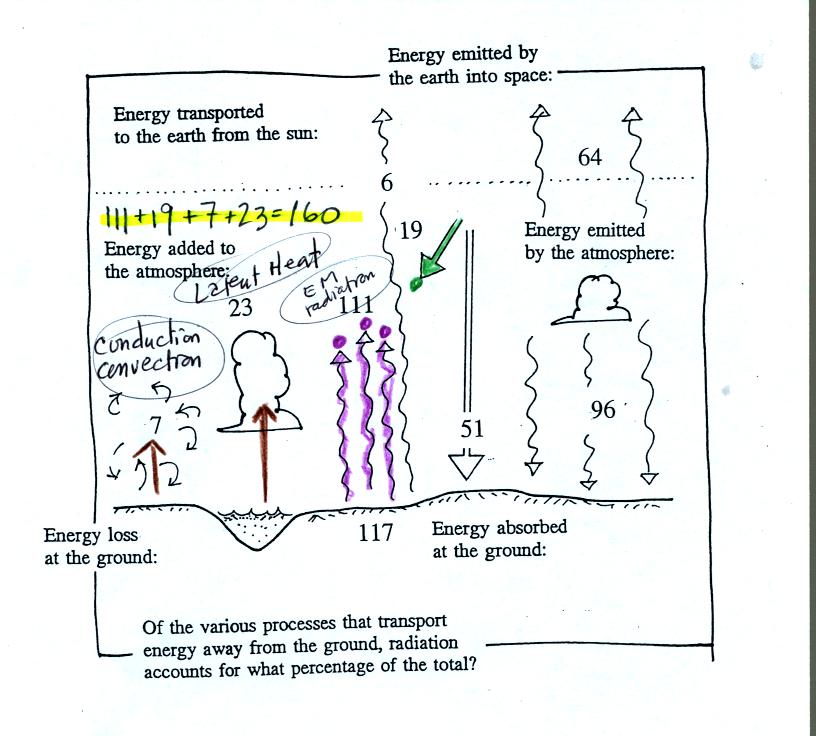
This figure shows the energy being added to the atmosphere. 19
units of sunlight are absorbed, 111 units of IR radiation emitted by
the earth are absorbed. This gives 130 units, we need a total of
160. Conduction and convection transport only 7 units, latent
heat transports 23 units from the ground to the atmosphere. They
account for the missing 30 units.
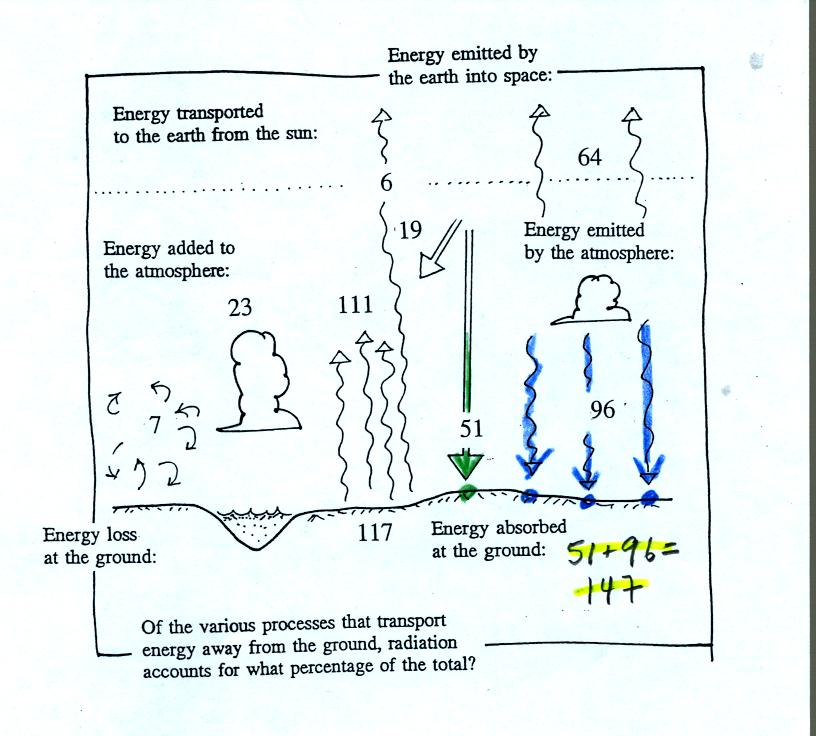
The ground absorbs 51 units of sunlight and 96 units of energy emitted
by the atmosphere. On average the ground gets more energy from
the atmosphere than it does from the sun.
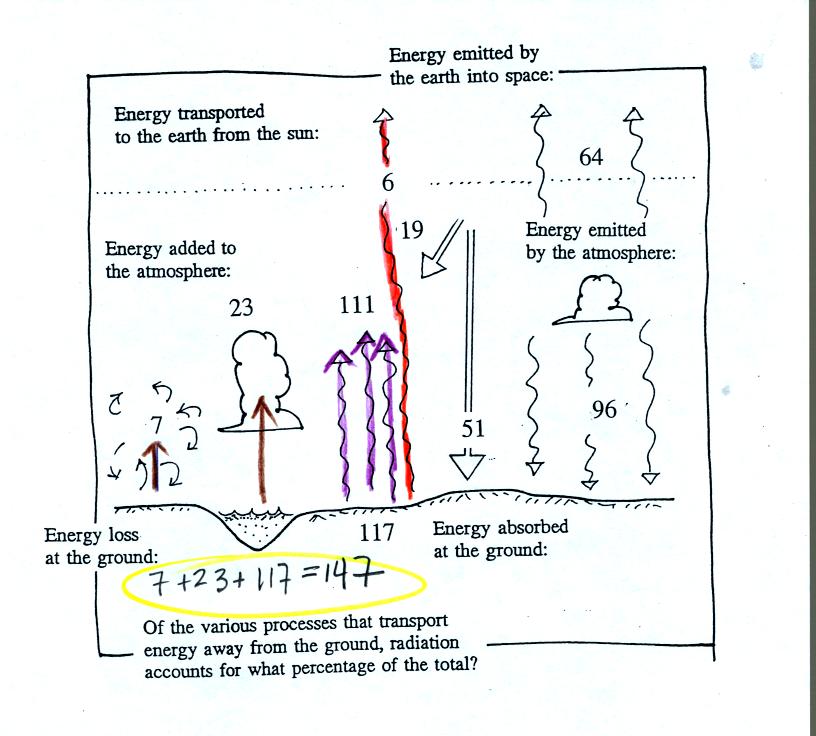
The ground loses 117 units of energy by emitting IR radiation.
Conduction, convection, and latent heat transport an additional 30
units away from the ground. That gives a total of 147 units, so
the ground is in energy balance. Note that 117 out of the total
147 units, 80%, lost by the ground is in the form ofEM radiation.
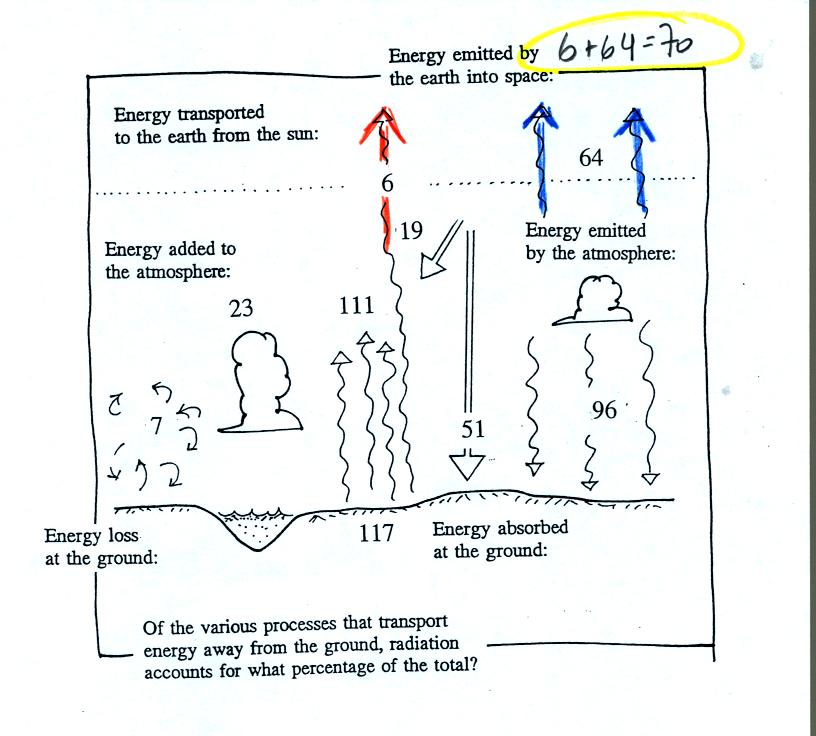
The earth and atmosphere send 70 units into space which balances the 70
units of sunlight absorbed by the atmosphere or the ground shown below.
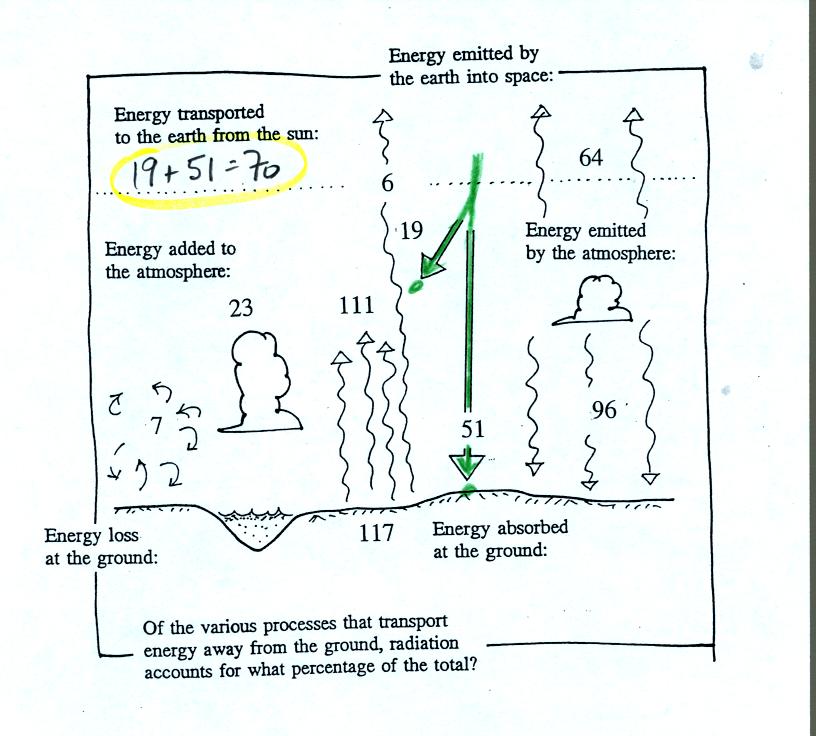
Note the 30 units of reflected sunlight is not included in this figure.
Now we
will go back to our original simplified view of the greenhouse effect,
modify it, and learn what happens at night and on cloudy days.

In the bottom figure the incoming sunlight has been removed
from the
energy balance diagram. The ground is emitting 3 units of energy
and getting 1 back from the atmosphere. That is a net loss of 2
units. The ground will cool fairly rapidly during the night.
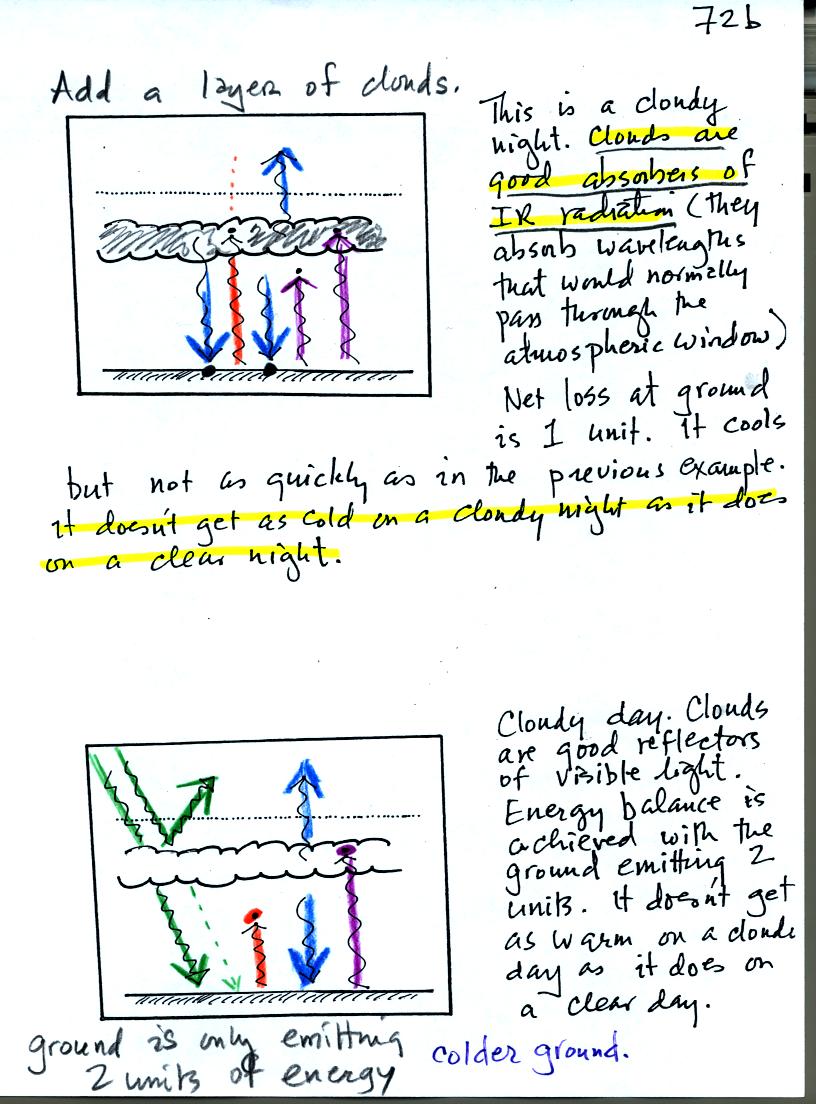
In the top figure it is still night but a layer of clouds
has been added. The clouds
are good absorbers of IR radiation even at wavelengths that would
otherwise pass through the atmosphere. If we were able to see IR
light instead of visible light, clouds would appear black - it is
surprising how the appearance of something can change depending on the
kind of light you are able to see.
Clouds reduce the net loss
of energy at the ground. The ground cools
more slowly and doesn't get as cold during the night.
The bottom figure above is a daytime figure (the sunlight is
back). The clouds will reflect some of the incoming sunlight and
reduce the daytime high temperatures.
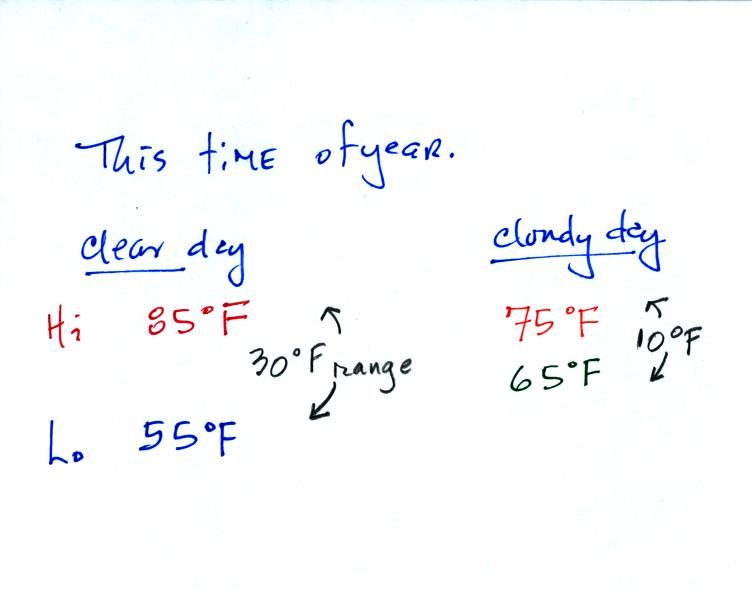
Typical daytime highs and nighttime lows in Tucson for mid
October. Note how the clouds reduce the daily range of
temperature.
One last
thing before we leave energy transport, energy balance, and the
greenhouse effect.
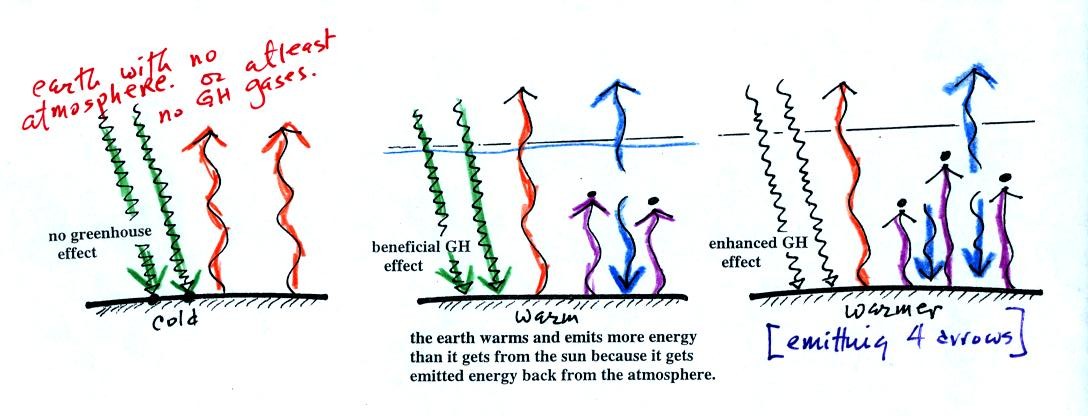
The figure on the left shows energy balance on the earth without
an atmosphere or with an atmosphere that doesn't contain greenhouse
gases (so that IR energy emitted by the ground isn't absorbed by gases
in the atmosphere). The ground only needs to emit 2 units of
energy to reach energy balance. The ground wouldn't need to be
very warm to do this.
In the middle picture the natural greenhouse effect is in
operation. The ground is warmer and emitting 3 units of
energy. It can do this even though it is only getting 2 units of
energy from the sun because greenhouse gases absorb some of the emitted
energy and emit some of it back to the ground.
In the right figure the concentration of greenhouse gases has increased
(due to human activities). The ground has warmed even more (global warming) and is now
emitting 4 units of energy and still only getting 2 from the sun.
But with more greenhouse gases, the atmosphere is now able to absorb 3
units of the IR emitted by the ground. The atmosphere sends 2
back to the ground and 1 up into space.
The next figure shows a common misconception about the cause of global
warming
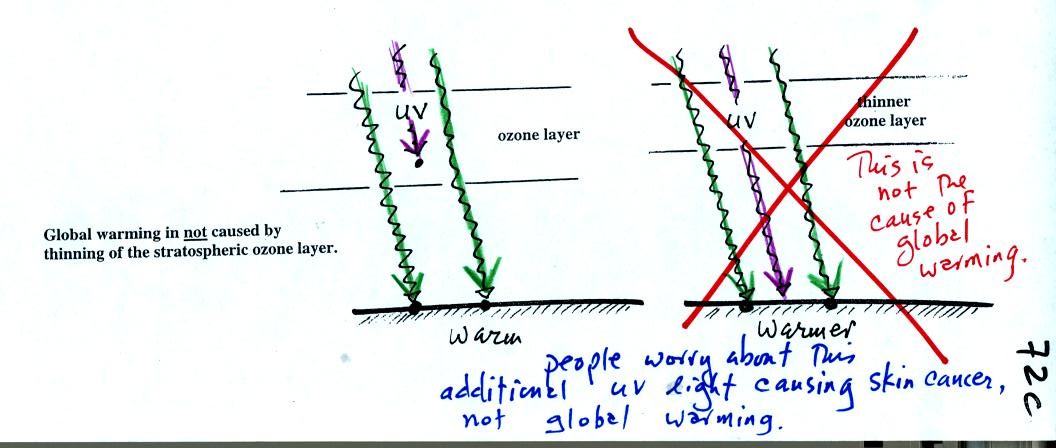
Many people know that sunlight contains UV light and that the ozone
absorbs much of the dangerous type of high energy radiation.
People also know that release of chemicals such as CFCs are destroying
stratospheric ozone and letting some of this UV light reach the
ground. That is all correct. They then conclude that it is
this additional UV energy that is causing the globe to warm. This
is not correct. There isn't much UV light in sunlight in the
first place and the small amount of additional UV light reaching the
ground won't be enough to cause global warming. It will cause
cataracts and skin cancer and those kinds of problems but not global
warming.












